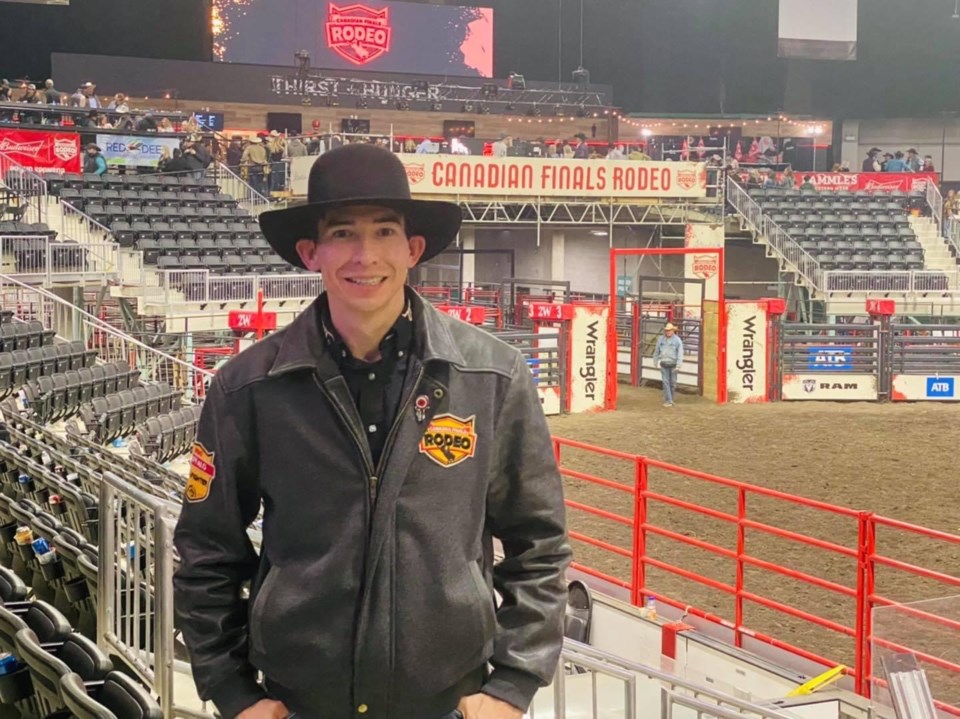Kristopher has rodeo in his genes as a fourth-generation Cree cowboy and a first-generation Cree bullfighter from Samson Cree Nation, Treaty 6 territory.
“This year I got voted into the Canadian Final Rodeo. It’s one of the main goals you want to achieve as a bullfighter – one of the top levels of being recognized as a bullfighter,” noted Kristopher.
Kristopher explained It was an honour to be voted by the top twelve men of Canadian bullfighting sport. He put a lot of effort into working toward his current achievements in rodeo.
“My accomplishments include CPRA finals in 2021. I made the Indian National Final Rodeo in 2021 and 2016. I also competed in the Bullfighter only competition in Las Vegas, continuously from 2017 to 2019,” said Kristopher.
“I have been fighting bulls for about fourteen years. I started as a rodeo school attendee. I come from a rodeo family from my father’s side of the family, Kirk Buffalo.”
Kristopher’s father is a respected community member of Samson Cree Nation with a family history in Cree tribal politics and Indigenous rodeo. The community of Maskwacis (Hobbema) was historically well known for top professional rodeos in Canada.
The patriarch of the Cree rodeo dynasty, Kirk Buffalo said he is very proud of his son’s achievements. “His cousin Todd Jr. Buffalo is a past CPRA champion (1994) and another cousin Bengy Buffalo was the 50th Ponoka Stampede Bullriding Champion.”
Outside of creating and cultivating a rodeo family, the Cree patriarch works for Correctional Service Canada in Cree restorative justice – a program that utilizes Cree cultural and spiritual teachings to prison inmates.
“The family supported Kris throughout his rodeo career,” noted Kirk. “He was raised on the Buffalo family rodeo ranch. As a youth, he helped build the family rodeo ranch too which is located on six mile. He was even a sheep rider as a kid.”
Kirk explained Cree people have always had a connection with animals. “In a way that shows respect for the four-legged such as moose, dogs, bulls, and horses.”
Kristopher is a proponent of hard work but he also encourages youth to dream.
His late aunt, Carolyn Buffalo taught him the acronym for becoming a champion: “Consistency, Hard Work, Attitude, Mental Toughness, and Patience… but youth need to know that patience is the key thing if you want to be a champion,” added Kristopher.
He said he wished his late aunt was here to witness his major achievements in Canadian Rodeo.
“She was very motivating and inspiring. I wish she was here to see me at this big stage in my life,” said Kristopher.
In a world that is dominated by white men. Kristopher holds his own in the rodeo arena and is currently the only 2021 pro-Indigenous bullfighter.
“I broke barriers in the Canadian Rodeo. I was often ‘the’ Indigenous person competing,” said Kristopher.
The family patriarch, Kirk shared a proud memory of when the family traveled to Dallas Texas to support Kristopher. “We came down to watch my son perform for the Dallas cowboys. There were a lot of Native Americans in the stands watching my son perform. We our people proud… My son is known internationally.”
Both Kirk and Kristopher talked about racism within Canadian Rodeo community but they never allowed that to get in the way of Kristopher’s ambitions and success. His focus was on being the best bullfighter and developing his skills in the arena.
“I want to thank my family for their support and my wife for allowing me to focus on doing my job. I was able to create a job out of a hobby. My wife let me go to rodeos while she took care of the kids and I’m grateful for that.”
This year he is only completing in the Cowboy Protection and this benefits the finals in Rodeo.
The Buffalo family comes from a community with a rich history and legacy in Rodeo. Past leaders of Maskwacis made large investments in the sport and infrastructure to support it.
According to Canadian Museum of History, “From the mid-seventies to the early eighties, the four First Nations (Montana, Ermineskin, Samson and Louis Bull) of Maskwacis in Alberta became extremely wealthy when oil was discovered on their reserves.
“Communities such as the Ermineskin and Montana First Nations used some of their financial resources to develop world-class multi-million dollar professional rodeo and horse-racing facilities.
“The Ermineskin First Nation opened the Panee Memorial Agriplex and Montana Reserve opened its multi-million-dollar complex, the Diamond 5 Rodeo Ranch. It too prospered as an internationally recognized rodeo facility from the early 1980s to the early 1990s.”
The Buffalo family offers programs and information can be found on their professional facebook page: @buffalobullfighter.




